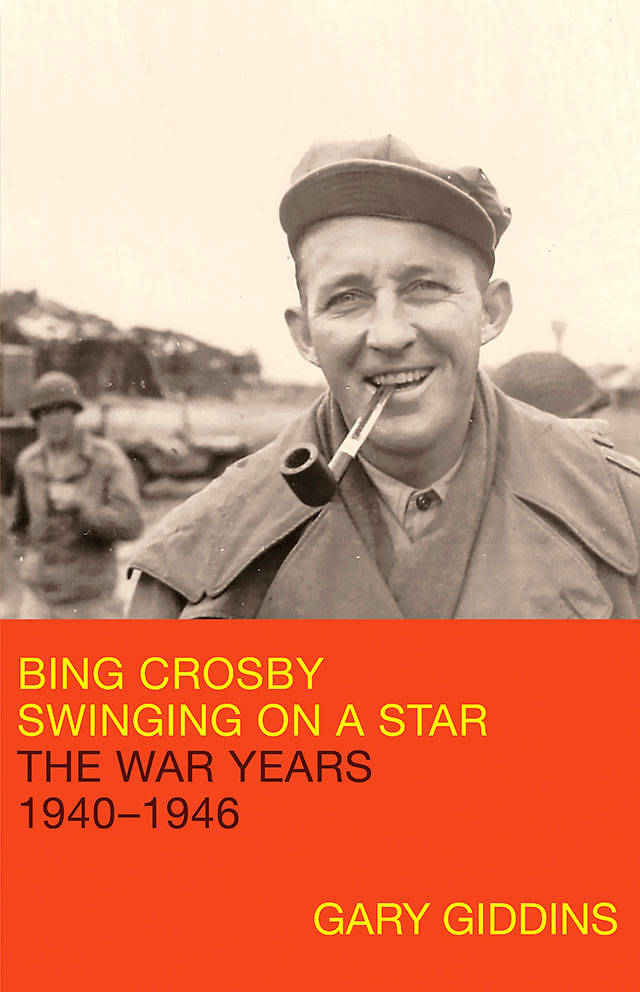By Wendy Smith / For The Washington Post
It’s been almost 18 years since the publication of “Bing Crosby: A Pocketful of Dreams,” Gary Giddins’ intelligent and formidably well-informed biography covering the entertainer’s life from his birth in 1903 through the film that launched his mega-grossing partnership with Bob Hope (“The Road to Singapore,” 1940). “Bing Crosby: Swinging on a Star” was worth the wait.
As in the first volume, Giddins makes Crosby’s career the framework for an astute account of broad shifts in the radio, record and movie industries. Crosby was a big star in 1940, but his fame was on another level by 1946. Giddins traces his trajectory across this eventful half-decade in a densely packed, sometimes excessively detailed narrative.
He begins with a snapshot of the troubled Crosby marriage in 1940, describing an evening when Bing came home from work on “The Road to Zanzibar” to find his wife, Dixie, drunkenly berating their four young sons. The marriage fell into a grim pattern during the World War II years: Dixie was mostly drunk; Bing was mostly gone. It didn’t help that Crosby’s personality — “impatient with introspection … stoic, manly, rarely nostalgic, never sentimental, and often flippant”— was poorly suited to dealing with a fragile spouse. Crosby twice considered divorce during this period, but each time was dissuaded by a priest; he had been raised and remained a devout Catholic.
Crosby was determined to end his relationship with “Kraft Music Hall,” the popular weekly radio program he hosted. It took five years to extricate himself, but during that time, he used his clout to get the show reduced from an hour to 30 minutes and began a long battle that would eventually transform radio from a live medium to a prerecorded one. Giddins covers this and other industry issues with his usual savvy. His critical prose, somewhat blunted in the first volume, is back at full incisiveness in a shrewd analysis of how broadcasters’ 1941 boycott of music licensed by copyright-enforcer ASCAP solidified Crosby’s connection to older forms of American popular culture. Decca responded to the boycott by recording Crosby singing Stephen Foster tunes and other public domain material, Giddins writes, which resulted in “a distillation of his style into its purest components — the peerless Crosby baritone as national security blanket.”
Giddins’ pen is at its sharpest in his account of Crosby’s film career as he skewers Hollywood’s manifold absurdities. Starlet Marilyn Maxwell, he wisecracks, was “a girl-next-door type, if your neighborhood was MGM.” Production Code enforcer Joseph Breen scrupulously monitored “Road to Zanzibar” to forestall any unseemly displays of female flesh, Giddins notes dryly, “while expressing no qualms about depicting a public slave market in modern-day Zanzibar.” He conveys with zest the relish Crosby and Hope took in evading such nonsense. In Crosby’s case, however, the kidding went only so far. “No matter how jolly or friendly he might seem, you knew there was that invisible line you did not cross,” commented a supporting player in another Crosby movie. “I doubt anyone knew him really well.”
Ironically, the tens of thousands of soldiers Crosby entertained during the war felt they knew him quite well. “What a guy, a regular guy, a real pal,” one man enthused in a letter to his wife. “He brought home right to your heart.” Crosby’s wartime tours form the emotional center of this volume. They poignantly show him reaching out to audiences of strangers with a warmth he seldom offered to intimates. Crosby had been terrified of hospitals since his guitarist Eddie Lang — the only person he was truly close to, Giddins suggests — died after a botched tonsillectomy. But he gave shows to horribly wounded soldiers in field hospitals. He sang “White Christmas” over and over, even though he never sang it “without a wrench,” seeing battle-hardened men cry over a song they cherished as a reminder of home and peace. It was the least he could do for “the best audience we ever worked for,” which had rescued him from personal and professional malaise.
The reserve that frustrated his family was the key to Crosby’s popularity with the troops. “He (created) a particular kind of bond, a zone of emotional safety,” Giddins writes, adding pointedly, “A zone has boundaries.” The stern boundaries he established at home created a fraught dynamic with his sons and wife that Giddins analyzes with nuance and empathy for all parties. Crosby was much better at being a fictional “father” in “Going My Way,” the 1944 film that won Crosby critical respect and an Academy Award for his role as a hip young Catholic priest. He entered the postwar period as “a bulwark of stability and reassurance,” a dominant presence on film, record and radio.
It must be noted, with regret, that Giddins has a terrible weakness for unnecessary material. We don’t need minute analysis of lackluster performances of trivial songs in each recording session. Twelve pages of background on “Going My Way” director Leo McCarey is too much, no matter how important a role he played in Crosby’s professional development. The worst failure of Giddins’ editorial judgment is his decision to close the book with endless excerpts from the diary of a teenage Crosby fan, who chronicles her uninteresting interactions in the winter of 1945-46 at excruciating length. Her entries bring to a jarring conclusion Giddins’ evocative portrait of a man and a historical moment, which would be even better if it were about 100 pages shorter.
Talk to us
> Give us your news tips.
> Send us a letter to the editor.
> More Herald contact information.

























